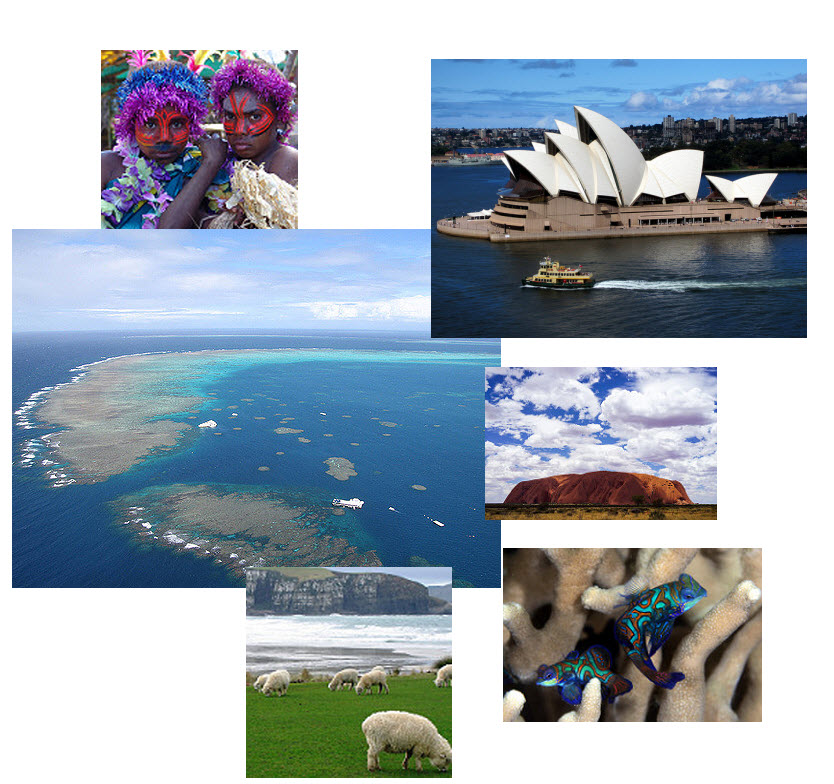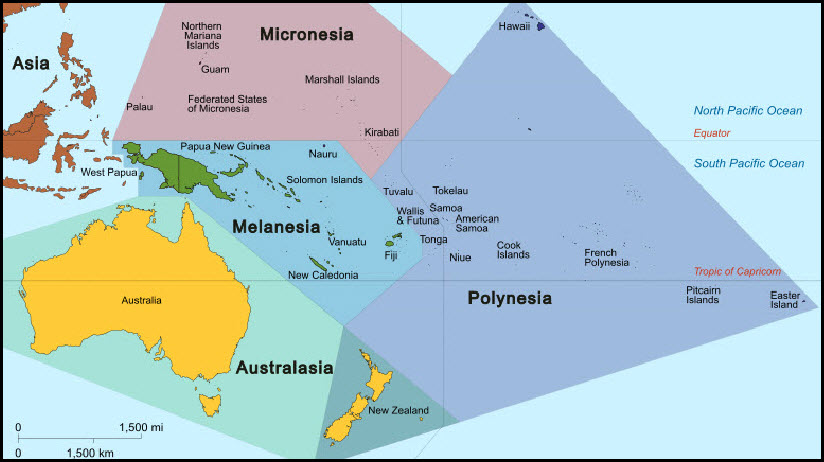4

Overview
Oceania is a region of the world that has gone through a considerable amount of political change in the last century from New Zealand being the first country to allow women to vote and Papua New Guinea finally switching from seashells to a recognized currency. Visitors to the region will want to pay close attention to numerous languages and religions. Cultural differences have become an area of conflict between natives, non-natives, and immigrants.Oceania is a region centered on the islands of the tropical Pacific Ocean. Oceania is often used specifically to denote Australia and New Zealand, but it also includes Melanesia, Micronesia, Polynesia, Australasia, and the Malay Archipelago.
Australia is distinctive because it is an island, a country, and a continent—the smallest of the world’s continents. No other land mass can make those three claims. Australia consists of a large mainland and the island of Tasmania to the south. The main physical area of New Zealand, on the other hand, consists of two main islands separated from Australia’s southeastern region by the Tasman Sea. The Great Barrier Reef runs for more than 1,600 miles off the continent’s northeastern shores. The Coral Sea separates the Great Barrier Reef from the South Pacific. The southern side of Australia is the Great Australian Bight and the island of Tasmania. A bight is a large, wide bay. To the south of Australia and New Zealand is Antarctica. The two countries have distinct physical geographies. Australia is relatively flat with low elevation highlands and an extensive dry interior, while New Zealand has high mountains and receives adequate rainfall.
The Pacific realm is home to many islands and island groups. The largest island is New Guinea, which is home to most of the realm’s population. The many islands can be divided into three main groups based on physical geography, local inhabitants, and location: Melanesia, Micronesia, and Polynesia. Indigenous cultural heritage remains strong in the South Pacific, but Western culture has made deep inroads into people’s lives. Western trends in fast food, pop music, clothing styles, and social customs often dominate television, radio, and the cinema. Invasive Western cultural forces take the focus away from the traditional indigenous culture and heritage of the people who inhabited these isolated islands for centuries.
Map of Oceania

Suggested Research Links for Oceania
In this section you will find website links to additional resources to help enhance your research. Your research for your assignments are not limited to the resources that we provide. Please expand your research above and beyond this list.
CIA World Factbook
- https://www.cia.gov/library/publications/the-world-factbook/
- The World Factbook is a reference resource produced by the Central Intelligence Agency with almanac-style information about the countries of the world.
Lonely Planet – Australia and Pacific
- https://www.lonelyplanet.com/pacific
- Lonely planet is the largest travel travel guide book publisher in the world.
Nomadic Matt – Oceania
- http://www.nomadicmatt.com/travel-guides/
- Nomadic Matt is a travel blog and website that was created by the author of the New York Times best-selling book, How to Travel the World on $50 a Day. This site expresses how to travel on a budget.
Rough Guides – Oceania
- http://www.roughguides.com/destinations/australasia/
- Rough guides is a “tell it like it is” travel guide with contemporary writing and up-to-date information.
Travel and Leisure Online
- http://www.travelandleisure.com/
- This travel site offers world news, travel tips, guides and information on the top destinations of the world. This resource also includes articles, videos, guides to lodging and restaurants.
Weather and Climate
- https://weather.com/
- Resource to local weather from around the world.
BBC Online
- http://www.bbc.co.uk/religion/religions/
- This resource offers a brief description of the major religions of the world.
Wandering Earl – Travel Blog
- http://wanderingearl.com/
- A personal travel blog that describes his adventures from traveling the world.
Eating Around the World
- http://globaltableadventure.com/
- Over 650+ food recipes from around the world!
Vagabrothers
- https://www.youtube.com/user/vagabrothers
- Two brothers travel around the world on a budget and create video blogs to explore the world and its people.
Travel Channel
- http://www.travelchannel.com/interests/travel-tips
- On this resources you will find tricks and tips on how to be a safe traveler. Topics include packing, lodging and transportation.